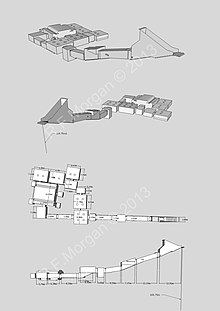KV7
|
KV7 |
|
|---|---|
| place | Valley of the Kings |
| Discovery date | in ancient times |
| excavation | Henry Salt (1817), Karl Richard Lepsius (1844), Harry Burton (1913/14), Christian Leblanc (1995) |
| Previous KV6 |
The following KV8 |
The tomb KV7 is the burial place of the ancient Egyptian king ( pharaoh ) Ramses II ( Ramses the great ) of the 19th dynasty . It is centrally located in the Valley of the Kings , opposite the tomb of his sons, KV5 and not far from that of his son and successor, Merenptah , KV8 .
Construction and decoration
The burial chamber is located in the center of the burial place and has a vaulted ceiling. Parts of the decorations have been damaged or even destroyed by the constant floods that also reached the tomb. Still recognizable are the wall paintings with the litany of Re , the Book of the Portals , the Book of the Dead , the Amduat , the Book of the Cow and scenes of the mouth opening ceremony .
The mummy of Ramses II was brought to the cachette of Deir el-Bahari in the 22nd dynasty to protect against grave robbers . The actual grave was then used again for burials in the Third Intermediate Period and in the Roman Period .
See also
literature
- Nicholas Reeves , Richard H. Wilkinson : The Valley of the Kings. Mysterious realm of the dead of the pharaohs. Bechtermünz, Augsburg 2000, ISBN 3-8289-0739-3 , pp. 140-143
Web links
- Theban Mapping Project: KV7 (English)
Individual evidence
- ↑ Excavations in the Valley of the Kings: KV7
- ↑ Christian Leblanc: The Tomb of Ramesses II and Remains of His Funerary Treasure ( Memento from September 19, 2006 in the Internet Archive ) (English)
Coordinates: 25 ° 44 ′ 26 ″ N , 32 ° 36 ′ 6 ″ E

